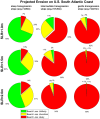Scalable, data-assimilated models predict large-scale shoreline response to waves and sea-level rise
- PMID: 39543131
- PMCID: PMC11564573
- DOI: 10.1038/s41598-024-77030-4
Scalable, data-assimilated models predict large-scale shoreline response to waves and sea-level rise
Abstract
Coastal change is a complex combination of multi-scale processes (e.g., wave-driven cross-shore and longshore transport; dune, bluff, and cliff erosion; overwash; fluvial and inlet sediment supply; and sea-level-driven recession). Historical sea-level-driven coastal recession on open ocean coasts is often outpaced by wave-driven change. However, future sea-level-driven coastal recession is expected to increase significantly in tandem with accelerating rates of global sea-level rise. Few models of coastal sediment transport can resolve the multitude of coastal-change processes at a given beach, and fewer still are computationally efficient enough to achieve large-scale, long-term simulations, while accounting for historical behavior and uncertainties in future climate. Here, we show that a scalable, data-assimilated shoreline-change model can achieve realistic simulations of long-term coastal change and uncertainty across large coastal regions. As part of the modeling case study of the U.S. South Atlantic Coast (Miami, Florida to Delaware Bay) presented here, we apply historical, satellite-derived observations of shoreline position combined with daily hindcasted and projected wave and sea-level conditions to estimate long-term coastal change by 2100. We find that 63 to 94% of the shorelines on the U.S. South Atlantic Coast are projected to retreat past the present-day extent of sandy beach under 1.0 to 2.0 m of sea-level rise, respectively, without large-scale interventions.
© 2024. This is a U.S. Government work and not under copyright protection in the US; foreign copyright protection may apply.
Conflict of interest statement
Figures





References
-
- Hapke, C. J., Plant, N. G., Henderson, R. E., Schwab, W. C. & Nelson, T. R. Decoupling processes and scales of shoreline morphodynamics. Mar. Geol.381, 42–53 (2016).
-
- Larson, M. & Kraus, N. C. Prediction of cross-shore sediment transport at different spatial and temporal scales. Mar. Geol.126(1–4), 111–127 (1995).
-
- Murray, A. B. Reducing model complexity for explanation and prediction. Geomorphology90(3–4), 178–191 (2007).
-
- Vitousek, S., Barnard, P. L. & Limber, P. Can beaches survive climate change?. J. Geophys. Res. Earth Surf.122(4), 1060–1067 (2017).
-
- Hoagland, S. W. et al. Advances in morphodynamic modeling of coastal barriers: A review. J. Waterw. Port Coast. Ocean Eng.149(5), 03123001 (2023).
LinkOut - more resources
Full Text Sources
Research Materials
Miscellaneous

